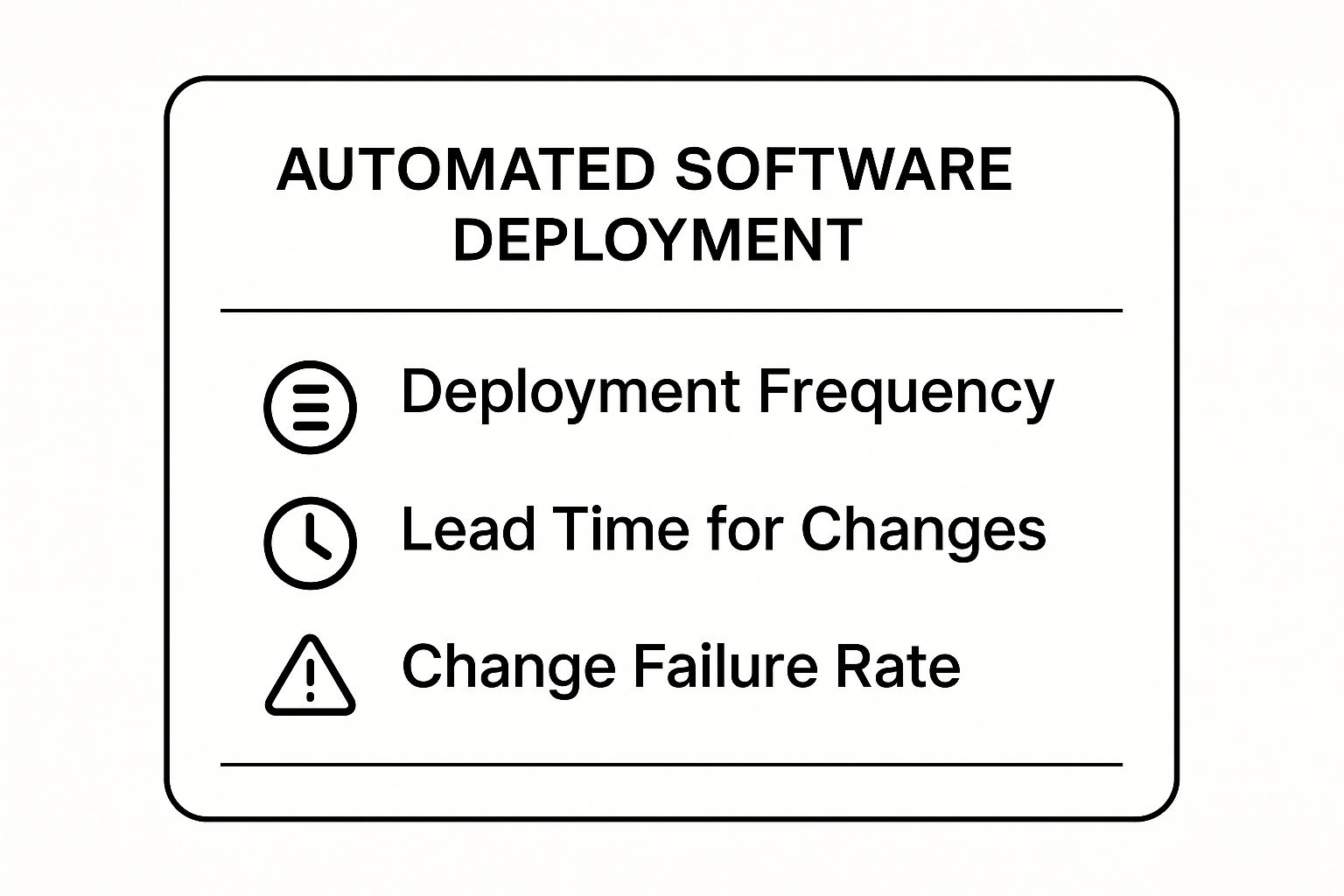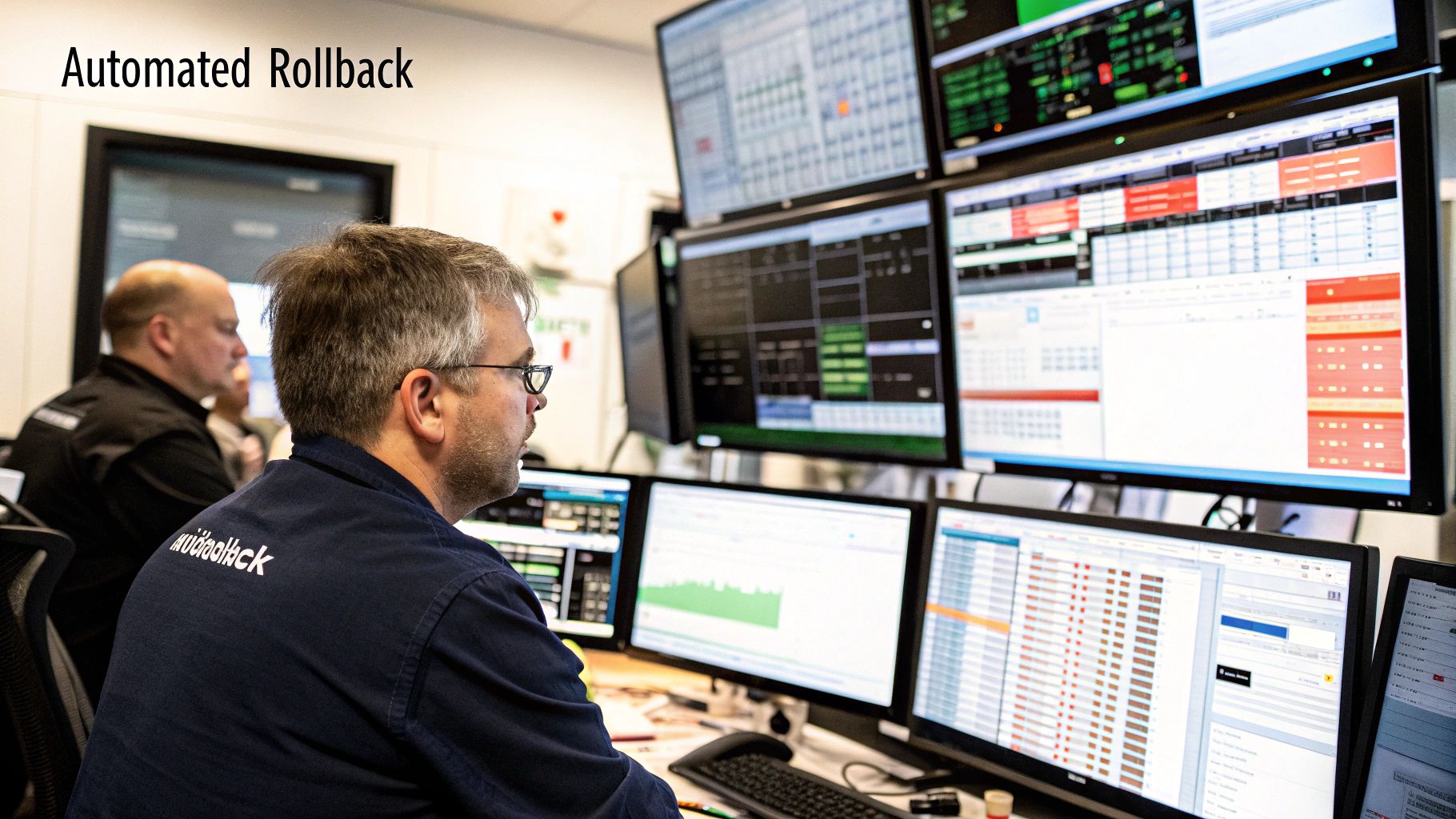Automated software deployment is all about using tools to get your new code from a developer’s machine into the hands of your users, with as little manual meddling as possible. It’s really the heart and soul of modern DevOps, making your release process quicker, far more dependable, and a whole lot less stressful for your team.
Why Automated Deployment Is No Longer Optional
Do you remember “deployment weekends”? The whole team would bunker down, fueled by cheap pizza and endless coffee, manually pushing new code to production servers. It was a nerve-wracking process where every single step was a landmine, rollbacks were a chaotic mess, and everyone just crossed their fingers, hoping the site wouldn’t crash. That whole high-stakes, glacial-paced approach just doesn’t cut it anymore in a world that expects constant improvement and new features.
Making the switch to automated software deployment isn’t just about following the latest trend; it’s a massive shift in how the best engineering teams build and ship software. When you take people out of the repetitive parts of the process, you get rid of the number one cause of deployment failures: human error. This evolution from risky, manual releases to efficient, predictable pipelines is what truly separates the innovators from the teams that are just trying to stay afloat.
The Real-World Impact of Automation
Think about a typical scenario. A development team is manually pushing updates to their e-commerce website. This involves several engineers, a massive checklist, and planned downtime that frustrates customers. One tiny mistake a forgotten environment variable or a missed configuration step and the entire platform could go dark, racking up thousands in lost sales every minute.
Now, let’s picture that same team with a well-oiled automated pipeline. As soon as a developer merges their code, a chain reaction kicks off automatically:
- Builds and Tests: The code is instantly compiled and put through a battery of unit and integration tests.
- Staging Deployment: Once the tests pass, the new version is pushed to a staging environment that’s an exact replica of production.
- Automated Checks: More tests run on the staging server, including crucial security scans and performance checks.
- Production Release: After a final sign-off (which can also be automated), the update goes live to customers with absolutely zero downtime.
This is what a modern deployment process actually looks like in practice.
The real magic here is consistency. Automation guarantees that the exact same steps are followed every single time you release code, whether it’s a tiny bug fix or a huge new feature. That predictability gives everyone confidence and lets your developers get back to what they’re paid to do: building great software.
This move towards automation is happening everywhere. In India, for instance, the appetite for these technologies is growing fast. A recent survey suggests that by 2025, around 84% of Indian firms will have adopted enterprise-wide Robotic Process Automation (RPA), which is built on the same core ideas as automated software deployment. But even with that big number, most companies are just getting started, which shows there’s a huge opportunity for improvement and a real need for people with these skills. You can dig into the numbers and see how automation is changing businesses in this detailed survey report. The data makes it clear: automating your processes is becoming non-negotiable for staying competitive.
Building Your First Deployment Pipeline

Jumping from the idea of automated deployment to actually building your first pipeline can feel daunting. But here’s the secret: your first pipeline doesn’t need to be a complex, all-singing, all-dancing masterpiece. The real goal is to start small, build a solid foundation, and then improve it over time. Let’s move past the theory and get our hands dirty with the practical steps.
Everything kicks off the moment a developer commits their code. That commit is your trigger. The pipeline’s very first job is to hook into your source control repository, like Git, and listen for those changes. This connection is the spark that ignites the entire automation sequence.
Establishing the Core Stages
Once you’ve connected to your source control, it’s time to map out the core stages of your pipeline. Think of these as the mandatory checkpoints your code must clear before it gets anywhere near production.
For a typical web application, a simple yet powerful structure includes these stages:
- Build Stage: The pipeline grabs the latest code and compiles it into a runnable artifact. This could mean creating a Docker image for a containerised app or packaging files for a traditional server.
- Test Stage: This is your quality gate. Here, the pipeline runs all your automated tests unit, integration, and maybe a few basic end-to-end checks. If a single test fails, the pipeline halts immediately. Bad code doesn’t proceed. Simple as that.
- Deploy to Staging: With tests passed, the build is automatically pushed to a staging environment. This environment needs to be a near-perfect replica of production, giving you a space for final validation before the real deal.
This straightforward three-stage setup creates an incredibly valuable feedback loop. Developers get quick, consistent feedback on their work without anyone needing to lift a finger.
The ultimate goal is to make deployments boring. Your first pipeline should make the process so repeatable and predictable that it becomes a non-event. If you can get to the point where a single commit triggers a successful deployment to staging, you’ve already reclaimed countless hours and dramatically reduced risk.
Making Key Decisions for Scalability
As you lay this groundwork, you’ll hit a couple of key decision points that will shape your pipeline’s future. The first is your branching strategy. Will you adopt a structured model like GitFlow, with its dedicated feature and release branches, or will you go for a simpler trunk-based development approach? From my experience, trunk-based development often works better with fast-paced, highly automated environments.
Your choice of tools is another crucial consideration. There’s a whole ecosystem of options out there, but modern platforms like GitHub Actions or GitLab CI are fantastic places to start. They integrate tightly with your source code, allowing you to define your pipeline as code right inside your project. If you’re weighing your options, you might find our detailed comparison of popular CI/CD pipeline tools helpful.
This move toward automated software deployment is really an evolutionary process. The concept itself has a long history. As far back as 1964, the PDP-6 computer came with manufacturer-supplied software that included time-sharing applications—an early, primitive form of automated deployment. This foundational work set the stage for the sophisticated CI/CD practices that Indian software firms and IT service providers now depend on to operate efficiently at scale. It’s fascinating to see how far we’ve come.
How To Choose Your Deployment Automation Tools
Picking the right tools for your deployment pipeline is one of the most important decisions you’ll make. It’s not about finding a single “best” tool; it’s about assembling a toolchain that genuinely works for your team, your budget, and your specific project needs. With so many options out there, it’s easy to get overwhelmed, but a clear focus on your requirements will light the way.
Think of it in layers: you have your CI/CD platform, your containerisation tech, and your infrastructure management tools. For each piece of the puzzle, you need to consider the cost, the learning curve for your team, the strength of its community support, and how smoothly it will integrate with the systems you already have in place.
Assessing Your CI/CD Platform Options
The CI/CD server is the engine of your entire pipeline. It’s what kicks off builds, runs your tests, and pushes code to your environments. For years, Jenkins has been the go-to choice for many teams. Its power lies in its incredible flexibility and a massive ecosystem of plugins, making it a great option if you need to build something highly customised. But that power comes at a price: a steeper learning curve and a lot more hands-on maintenance.
Lately, more integrated platforms like GitLab CI/CD and CircleCI have gained huge popularity. They offer a much more user-friendly experience, allowing teams to define their pipelines as code right inside their git repositories. This approach is cleaner, easier to manage, and fits perfectly with modern DevOps thinking. Our guide on DevOps automation dives deeper into how these platforms anchor a wider strategy.
This space is booming. The global deployment automation market is on track to hit a valuation of around $15 billion in 2025, with experts predicting a growth rate of 18% through 2033. This surge is particularly noticeable in markets like India, where the move to cloud-native development and microservices is fuelling a massive demand for dependable deployment tools. You can get more insight into these trends from this detailed industry report.
The best tool is the one your team will actually use and master. A platform packed with features that nobody understands is far less valuable than a simpler tool that everyone on the team can operate with confidence.
Comparing Popular CI/CD Tools for Modern Teams
To help you decide, here’s a quick comparison of some of the top CI/CD platforms. This table breaks down their key features, helping you align your project’s scale, hosting needs, and budget with the right solution.
| Tool | Best For | Hosting Options | Key Strengths | Considerations |
|---|---|---|---|---|
| Jenkins | Teams needing deep customisation and control | Self-hosted | Unmatched plugin ecosystem, highly flexible | Steeper learning curve, high maintenance |
| GitLab CI/CD | Teams already using GitLab for source control | Cloud (SaaS) & Self-hosted | Tightly integrated, simple YAML configuration | Best experience is within the GitLab ecosystem |
| CircleCI | Teams wanting fast setup and performance | Cloud (SaaS) & Self-hosted | Performance-focused, user-friendly interface | Free tier has limits on concurrent jobs |
| GitHub Actions | Projects hosted on GitHub | Cloud (SaaS) | Seamless GitHub integration, large community marketplace | Primarily tied to the GitHub platform |
Ultimately, the best choice depends on your existing ecosystem and how much control versus convenience your team values.
Containerisation and Infrastructure Choices
Your CI/CD pipeline is just one part of the equation. You also need tools to package and run your applications reliably across different environments. Docker is the undisputed standard for containerisation, but it’s always smart to keep an eye on alternatives like Podman, which offers a daemonless architecture that can improve security.
For managing the underlying infrastructure, Infrastructure as Code (IaC) is a must. Tools like Terraform are brilliant for provisioning cloud resources from different providers (like AWS, Azure, or GCP). On the other hand, Ansible shines when it comes to configuration management and deploying applications onto that infrastructure. In fact, many high-performing teams use them together Terraform to build the house and Ansible to furnish it.
Getting this toolchain right is what enables elite teams to achieve incredible results.

These numbers aren’t just vanity metrics. They show a direct link between effective automation and the ability to release more frequently, deliver value faster, and maintain a stable, reliable service. When you choose your tools thoughtfully, you’re laying the foundation for this exact level of performance.
Deploying with Confidence Using Advanced Strategies

So, you’ve built a functional CI/CD pipeline. That’s a huge win, but it’s really just the beginning. To truly turn stressful, all-hands-on-deck deployments into a boring, everyday routine, you need to think beyond simple automation. The best teams in the business don’t just deploy automatically; they use sophisticated techniques that make catastrophic failures a thing of the past.
These advanced strategies are all about minimising the “blast radius.” Instead of a high-stakes, big-bang release where everything goes live at once, you orchestrate a controlled, gradual rollout. This simple shift in mindset is what separates a basic pipeline from a truly mature automated software deployment practice.
Achieving Zero Downtime with Blue-Green Deployments
The idea behind a Blue-Green deployment is brilliantly straightforward. You run two completely identical production environments, which we’ll call “Blue” and “Green.” At any given moment, only one of them is live and handling user traffic let’s say it’s Blue.
When it’s time to release a new version, you deploy it to the idle environment, Green. This is your safe space. You can hammer it with automated smoke tests, double-check configurations, and perform any final validation you need, all without a single user being affected.
Once you’ve got the green light and are confident everything is solid, you simply flip a switch at the router level. All incoming traffic is now directed from Blue to Green. The switch itself is instant, meaning your users experience zero downtime. The old Blue environment sits on standby, ready to become the target for the next release or, crucially, to serve as an immediate rollback if something goes wrong with the new version.
This approach practically eliminates the stress of release day. Of course, keeping both environments perfectly in sync is vital, which is where solid DevOps configuration management becomes absolutely essential for a smooth transition.
Testing New Code Safely with Canary Releases
What if you’ve built a great new feature but aren’t quite ready to bet the farm by sending it to 100% of your users? This is the perfect scenario for a Canary release. This strategy is all about releasing new code to a small, controlled subset of your user base—your “canaries”—before rolling it out to everyone else.
You could, for instance, configure your load balancer to send just 1% of your traffic to the servers running the new version. Your monitoring and observability tools then become your best friend, as you watch this small group intently for any spike in errors, increased latency, or other negative signals.
- If everything looks healthy: You can start turning up the dial. Gradually increase the traffic share to 5%, then 25%, and so on, until 100% of your users are on the new version.
- If you spot trouble: You can instantly roll back the change by redirecting all traffic back to the stable, old version.
This method is incredibly powerful because it contains the damage of a potential bug. Instead of an outage that impacts your entire user base, you might only inconvenience a tiny fraction of them, giving you the chance to fix the issue before most people even knew there was one.
Gaining Ultimate Control with Feature Flags
Feature flags, sometimes called feature toggles, give you the most granular control imaginable. At their core, they are just simple if statements in your code that let you turn specific functionalities on or off for different users—all without needing to deploy new code. This is a game-changer because it completely decouples deploying code from releasing a feature.
Imagine your team has just finished a massive new reporting dashboard. You can merge and deploy that code to production with the feature flag turned off for everyone by default. The code is live, but it’s dormant and completely invisible to your users.
From there, you can selectively enable it for specific segments:
- Internal employees for dogfooding.
- A hand-picked group of beta testers.
- Users in a certain country or region.
This gives your product and engineering teams precise, real-time control. If a feature turns out to be buggy or confusing, a product manager can disable it with a single click in a dashboard. No emergency rollback, no frantic late-night deployment just a simple toggle.
Embedding Security into Your Automated Pipeline

It’s easy to get caught up in the speed of automation. But what good is a fast pipeline if it’s just shipping vulnerable code to production more quickly? That’s not progress; it’s a high-speed disaster waiting to happen.
True efficiency in automated software deployment means weaving security into every single stage of the process, not just bolting it on at the end. This is the core idea behind DevSecOps making security a shared responsibility that starts with the very first line of code.
This means leaving behind the old model of slow, manual security reviews. Instead, you build automated security checks directly into your CI/CD workflow. Think of them as security gates that your code must pass before it can move to the next stage. Catching issues early is always cheaper and faster.
Ultimately, the goal is to build a pipeline that isn’t just fast, but one that’s fundamentally trustworthy and resilient by design.
Managing Secrets Without Shortcuts
One of the most common and dangerous security blunders I see is hardcoding secrets directly into source code. Things like API keys, database passwords, and access tokens should never, ever live in your codebase. It’s a massive risk. If that code ever leaks, your most sensitive credentials are there for the taking.
The right way to handle this is with a dedicated secrets management tool. A platform like HashiCorp Vault is a great example. It acts as a centralised, secure safe for all your application secrets.
Your CI/CD pipeline can then be set up to programmatically fetch these secrets only when they’re needed during a build or deployment. This keeps credentials out of your Git repository and log files, which drastically reduces your attack surface. It’s a simple change that makes a world of difference.
Integrating Automated Security Scanning
To catch vulnerabilities before they ever reach production, you absolutely need to automate security scanning within your pipeline. These tools act as your tireless, automated security analysts, poring over every single build.
Here are the three essential types of scanning to implement:
- Static Application Security Testing (SAST): These tools analyse your source code for security flaws without actually running it. Think of it as a spellchecker for security holes, catching things like potential SQL injection or cross-site scripting flaws right after the code is written.
- Software Composition Analysis (SCA): Modern apps rely heavily on open-source libraries. SCA tools are crucial because they scan these dependencies for known vulnerabilities. A single compromised library can put your entire application at risk, so this isn’t optional.
- Dynamic Application Security Testing (DAST): Unlike SAST, DAST tools test your application while it’s running, usually in a staging environment. They actively probe your application from the outsidejust like a real attacker would to find vulnerabilities that only appear at runtime.
By integrating these scans, you ensure every commit is scrutinised for threats. The best practice is to configure the pipeline to automatically fail the build if a high-severity vulnerability is found. This stops insecure code dead in its tracks.
Enforcing Access Control and Auditing
Finally, a secure pipeline is one you can actually control and monitor. Implementing Role-Based Access Control (RBAC) is non-negotiable. This simply means that team members only have the permissions they absolutely need to do their jobs. A developer shouldn’t be able to single-handedly approve and push a deployment to production, for instance.
Alongside RBAC, you need a robust audit trail. Every single action taken within the pipeline from a code commit to a failed scan or a successful deployment must be logged. This gives you complete visibility and accountability, which is essential for troubleshooting and proving compliance with any industry regulations you might face.
Your Automated Deployment Questions Answered
Even after you’ve built your first pipeline, you’re bound to run into some practical questions. Working through the finer points of automated software deployment is a process, and getting clear answers to common roadblocks can be a real game-changer. Let’s tackle some of the most frequent questions I see teams grapple with as they get their automation sorted.
A lot of the initial confusion comes down to the language we use. It’s common to hear people use Continuous Delivery and Continuous Deployment as if they’re the same thing, but they actually describe two very different levels of automation and carry different risks. Knowing which is which is the first step in picking the right approach for your team.
What Is the Difference Between Continuous Delivery and Continuous Deployment?
Here’s the simplest way to think about it. Continuous Delivery means your code is always ready to be deployed. Every change that sails through your automated tests gets built and sent to a staging-like environment, waiting for the green light. The key part is that a person has to manually trigger that final push to production.
Continuous Deployment goes all the way. It gets rid of that final manual step. If a change passes every single automated check in the pipeline, it’s deployed straight to production without anyone needing to click a button. This is incredibly powerful, but it demands an immense amount of trust in your automated testing and monitoring systems.
How Should I Handle Database Migrations in an Automated Pipeline?
Database migrations are often the most nerve-wracking part of an automated pipeline because they can be a real headache to undo. The best way to handle them is to treat your database schema changes just like your code, using version-controlled scripts with tools like Flyway or Liquibase.
My biggest piece of advice here is to always design your migrations to be backward-compatible. This ensures that your new database schema can still work with the older version of your application code. This simple practice is a lifesaver, as it lets you roll back your application code if a deployment hits a snag, without bringing down the database for users still on the old version. The migration itself should be its own automated step in your pipeline, running before the new application code is deployed.
The best metrics give you a clear, data-backed view of your pipeline’s health. Don’t get lost chasing vanity metrics; concentrate on what truly reflects your team’s performance and the stability of your releases.
What Are the Most Important Metrics to Track?
When it comes to measuring how well your pipeline is performing, you really want to focus on the four key DORA metrics. They’ve become the industry standard for what separates high-performing DevOps teams from the rest.
- Deployment Frequency: How often are you actually shipping code to production?
- Lead Time for Changes: How long does it take for a code commit to make it all the way to production?
- Change Failure Rate: What percentage of your deployments end up causing a problem for users?
- Time to Restore Service: When something does go wrong, how fast can you fix it and get things back to normal?
Keeping an eye on these four numbers gives you a surprisingly complete picture of your engineering team’s efficiency and how stable your entire deployment process really is.
Ready to build a secure, scalable, and cost-effective cloud infrastructure? The expert team at Signiance Technologies can help you design and implement automated DevOps pipelines that drive business growth. Learn how we can transform your business.
